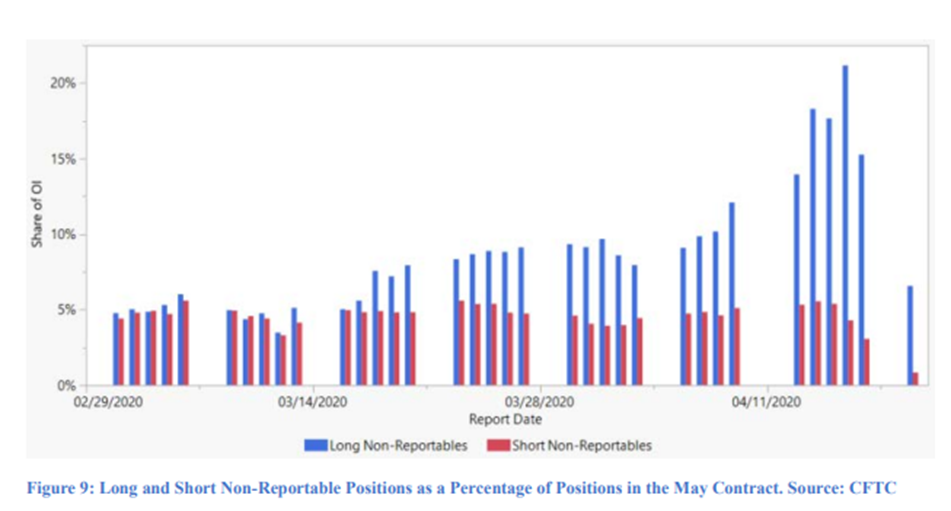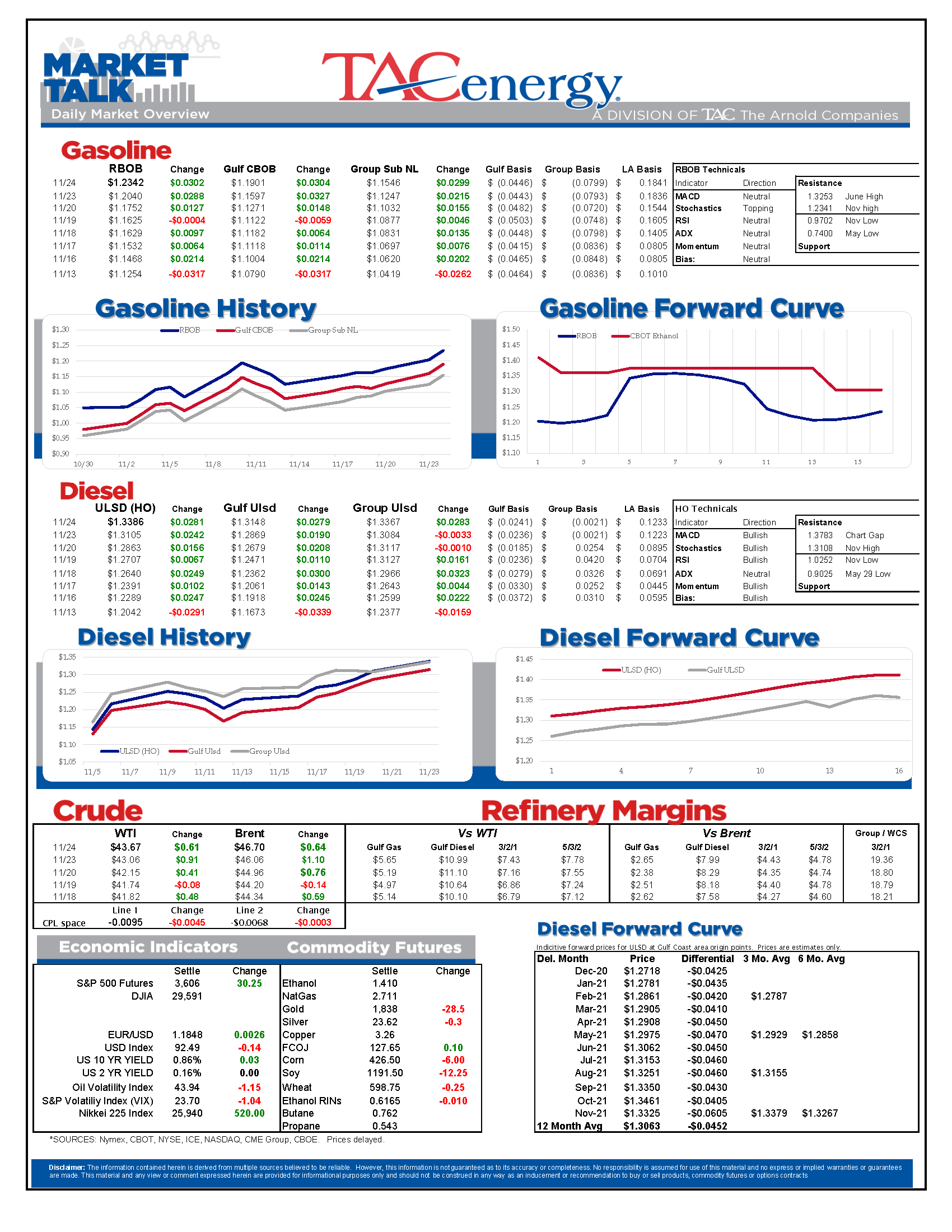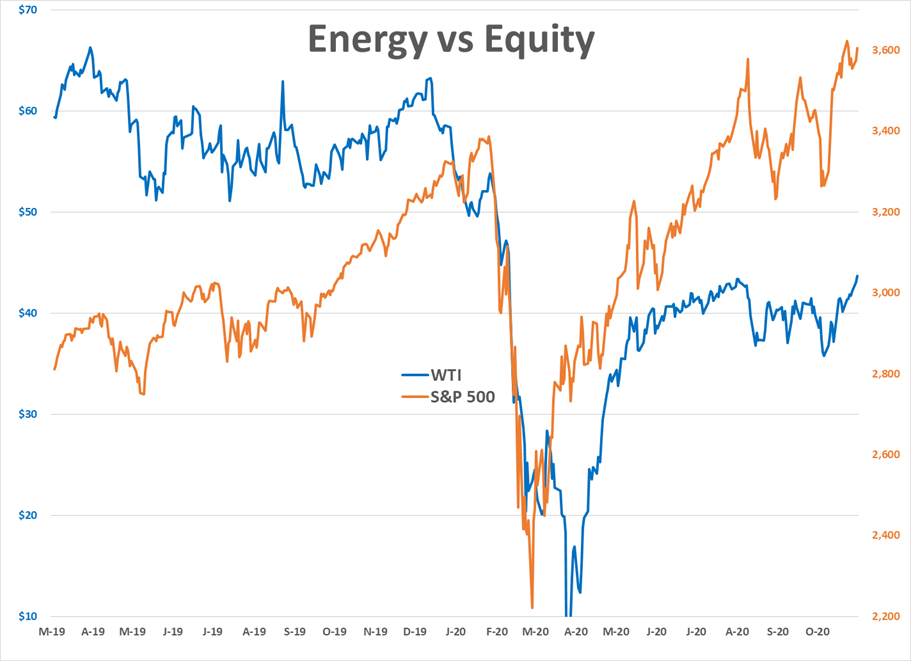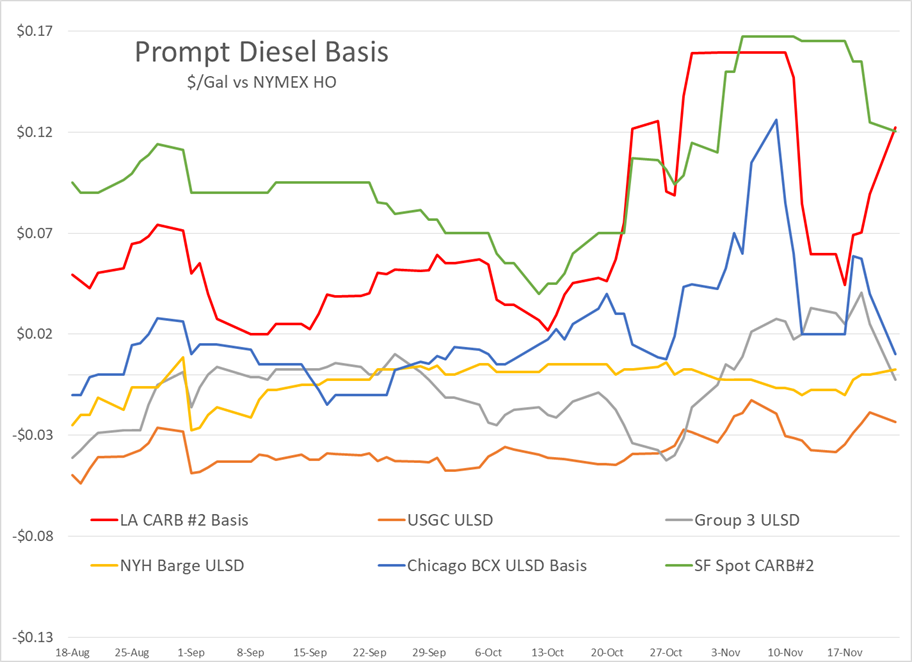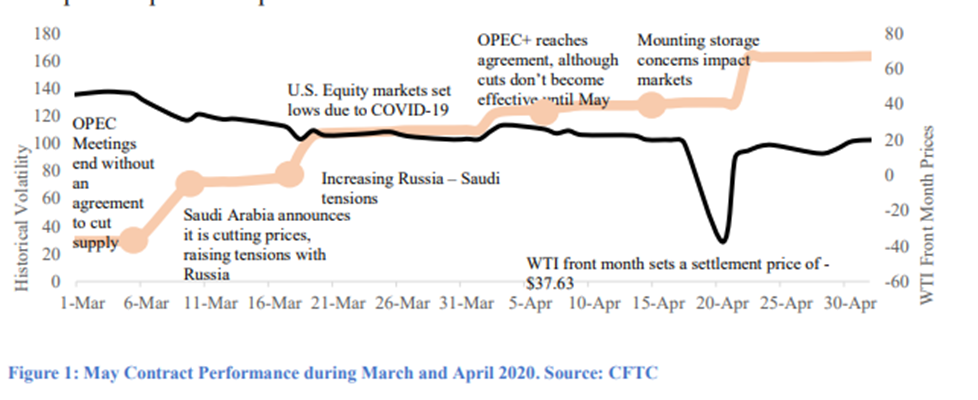Markets Cheer News Of New U.S. Treasury Secretary

Energy markets are on the cusp of a technical breakout to the upside with diesel prices hitting eight month highs, while crude and gasoline prices follow close behind.
Markets around the world seem to be cheering the news that Janet Yellen – the relatively market-friendly former FED Chair – is being tapped as the new U.S. Treasury Secretary. That move is seen by many as a sign that the new administration will be more focused on economic recovery than reform. In addition, reports that the Presidential transition is moving forward seems to be easing concerns over a protracted legal battle.
ULSD is trading higher for a seventh consecutive day, reaching a new eight month high and moving half way into the chart gap left behind during the March price collapse. WTI came within three cents of hitting an eight month high of its own overnight, setting up a critical test of the sideways trading pattern that’s contained the price action for June. There’s an interesting potential move on the WTI monthly chart, as the short lived selloff Sunday, November 1 and subsequent rally could make an outside up monthly bar that breaks both the low and the high ends of that sideways range. If prices can settle the month by breaking through the top end (near $44) there’s a strong case to be made that we’re soon going to see $50 crude.
Diverging diesel markets: Midwestern diesel spreads are collapsing this week after hitting their highest premiums in years as the annual post-harvest demand slump seems to be in full force across the region. Gulf coast values saw modest weakness in sympathy as the window to profitably ship barrels north has closed. West Coast values meanwhile are trading at double digit premiums to futures, with LA spots rebounding sharply from a mid-November slump, in what seems to be a reaction to a handful of unplanned refinery issues in the area.
The CFTC published a report on WTI’s plunge to negative values on April 20th. The report cites numerous fundamental and technical factors, and stops short of placing blame, and in many ways suggests the market performed as intended. The results are disappointing many who were looking for a smoking gun, and those that have a hard time understanding how complex commodity futures trading can be. One interesting point brought up in the report is the relatively high open interest in WTI in April, and the amount of positions held by “non-reportable” trading groups, meaning those with small enough positions they aren’t required to report to the CFTC. Those findings are consistent with earlier reports that suggested retail investors – many in China - were left holding the bag when they started trading in WTI without understanding how the contract really works.
NYMEX contracts will trade every day this week, although there will be no settlements published Thursday due to the Thanksgiving holiday in the U.S. Spot markets will not be assessed Thursday or Friday, so most rack prices will carry from Wednesday night through the weekend, even though futures will continue trading.
Click here to download a PDF of today's TACenergy Market Talk.
Latest Posts
Gasoline Futures Are Leading The Way Lower This Morning
The Sell-Off Continues In Energy Markets, RBOB Gasoline Futures Are Now Down Nearly 13 Cents In The Past Two Days
Week 15 - US DOE Inventory Recap
Prices To Lease Space On Colonial’s Main Gasoline Line Continue To Rally This Week
Social Media
News & Views
View All
Gasoline Futures Are Leading The Way Lower This Morning
It was a volatile night for markets around the world as Israel reportedly launched a direct strike against Iran. Many global markets, from equities to currencies to commodities saw big swings as traders initially braced for the worst, then reversed course rapidly once Iran indicated that it was not planning to retaliate. Refined products spiked following the initial reports, with ULSD futures up 11 cents and RBOB up 7 at their highest, only to reverse to losses this morning. Equities saw similar moves in reverse overnight as a flight to safety trade soon gave way to a sigh of relief recovery.
Gasoline futures are leading the way lower this morning, adding to the argument that we may have seen the spring peak in prices a week ago, unless some actual disruption pops up in the coming weeks. The longer term up-trend is still intact and sets a near-term target to the downside roughly 9 cents below current values. ULSD meanwhile is just a nickel away from setting new lows for the year, which would open up a technical trap door for prices to slide another 30 cents as we move towards summer.
A Reuters report this morning suggests that the EPA is ready to announce another temporary waiver of smog-prevention rules that will allow E15 sales this summer as political winds continue to prove stronger than any legitimate environmental agenda. RIN prices had stabilized around 45 cents/RIN for D4 and D6 credits this week and are already trading a penny lower following this report.
Delek’s Big Spring refinery reported maintenance on an FCC unit that would require 3 days of work. That facility, along with several others across TX, have had numerous issues ever since the deep freeze events in 2021 and 2024 did widespread damage. Meanwhile, overnight storms across the Midwest caused at least one terminal to be knocked offline in the St. Louis area, but so far no refinery upsets have been reported.
Meanwhile, in Russia: Refiners are apparently installing anti-drone nets to protect their facilities since apparently their sling shots stopped working.
Click here to download a PDF of today's TACenergy Market Talk.

The Sell-Off Continues In Energy Markets, RBOB Gasoline Futures Are Now Down Nearly 13 Cents In The Past Two Days
The sell-off continues in energy markets. RBOB gasoline futures are now down nearly 13 cents in the past two days, and have fallen 16 cents from a week ago, leading to questions about whether or not we’ve seen the seasonal peak in gasoline prices. ULSD futures are also coming under heavy selling pressure, dropping 15 cents so far this week and are trading at their lowest level since January 3rd.
The drop on the weekly chart certainly takes away the upside momentum for gasoline that still favored a run at the $3 mark just a few days ago, but the longer term up-trend that helped propel a 90-cent increase since mid-December is still intact as long as prices stay above the $2.60 mark for the next week. If diesel prices break below $2.50 there’s a strong possibility that we see another 30 cent price drop in the next couple of weeks.
An unwind of long positions after Iran’s attack on Israel was swatted out of the sky without further escalation (so far anyway) and reports that Russia is resuming refinery runs, both seeming to be contributing factors to the sharp pullback in prices.
Along with the uncertainty about where the next attacks may or may not occur, and if they will have any meaningful impact on supply, come no shortage of rumors about potential SPR releases or how OPEC might respond to the crisis. The only thing that’s certain at this point, is that there’s much more spare capacity for both oil production and refining now than there was 2 years ago, which seems to be helping keep a lid on prices despite so much tension.
In addition, for those that remember the chaos in oil markets 50 years ago sparked by similar events in and around Israel, read this note from the NY Times on why things are different this time around.
The DOE’s weekly status report was largely ignored in the midst of the big sell-off Wednesday, with few noteworthy items in the report.
Diesel demand did see a strong recovery from last week’s throwaway figure that proves the vulnerability of the weekly estimates, particularly the week after a holiday, but that did nothing to slow the sell-off in ULSD futures.
Perhaps the biggest next of the week was that the agency made its seasonal changes to nameplate refining capacity as facilities emerged from their spring maintenance.
PADD 2 saw an increase of 36mb/day, and PADD 3 increased by 72mb/day, both of which set new records for regional capacity. PADD 5 meanwhile continued its slow-motion decline, losing another 30mb/day of capacity as California’s war of attrition against the industry continues. It’s worth noting that given the glacial pace of EIA reporting on the topic, we’re unlikely to see the impact of Rodeo’s conversion in the official numbers until next year.
Speaking of which, if you believe the PADD 5 diesel chart below that suggests the region is running out of the fuel, when in fact there’s an excess in most local markets, you haven’t been paying attention. Gasoline inventories on the West Coast however do appear consistent with reality as less refining output and a lack of resupply options both continue to create headaches for suppliers.

